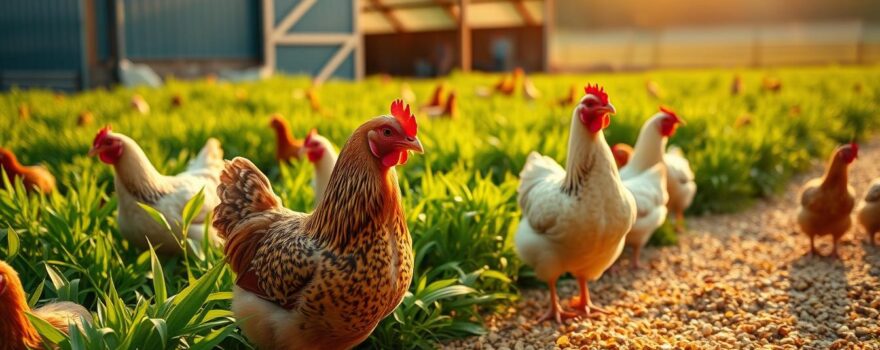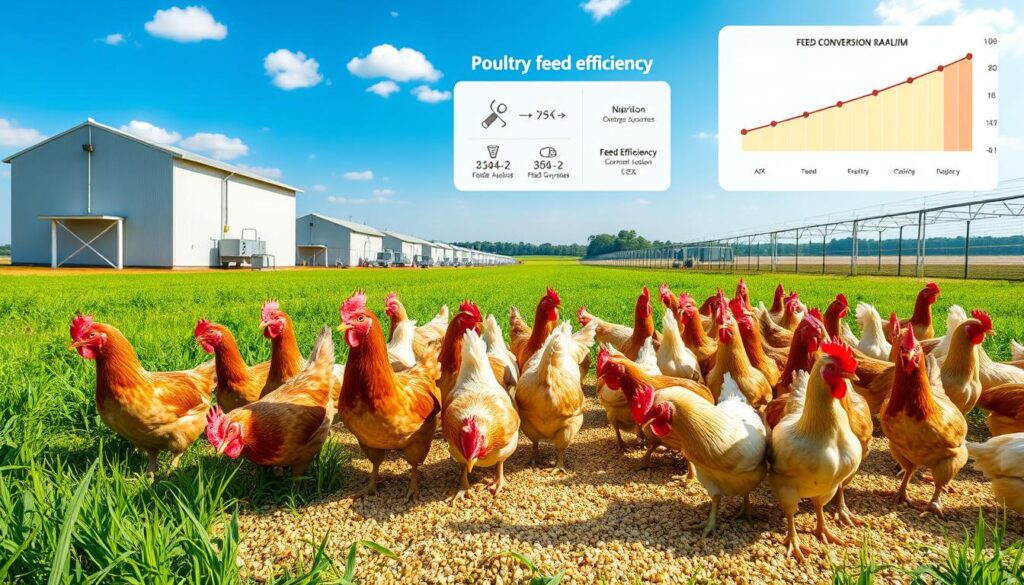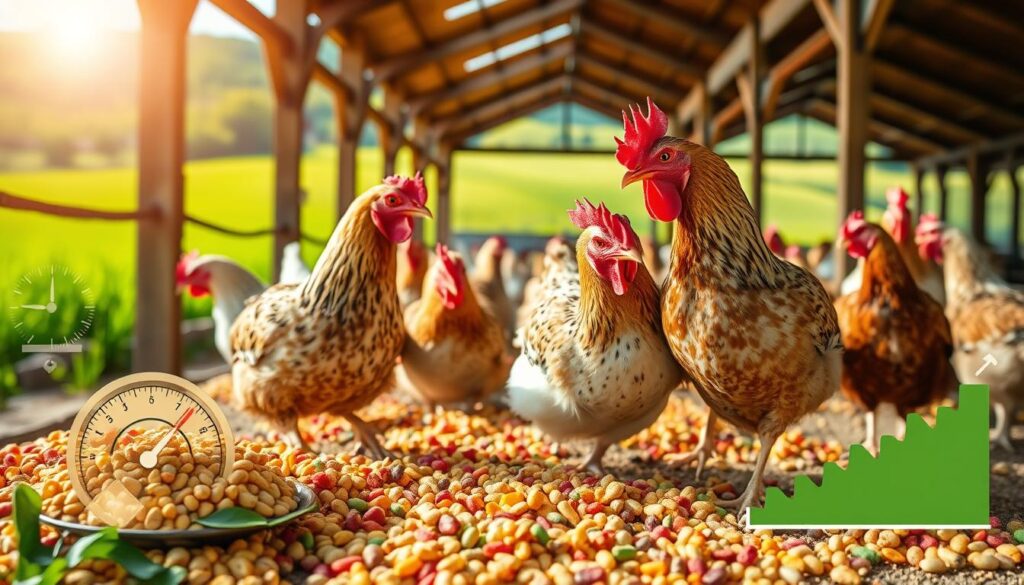
Measuring a business’s success in the poultry industry often focuses on one key metric: the feed conversion ratio (FCR). This ratio looks at how well a farm turns feed into weight or products like eggs. The cost of feed versus growth rate greatly affects a company’s profits. Finding the right balance can mean the difference between steady income and financial trouble.
This article will share effective ways to boost feed conversion ratios in broiler chickens. We’ll cover how to improve nutrition, management, and health for better farming results.
Key Takeaways
- Feed accounts for about three-fourths of all on-farm poultry production costs.
- Improving feed conversion ratio (FCR) can significantly boost profitability in broiler chicken farming.
- Strategies to enhance FCR include using high-nutrient feed, efficient feeders, and maintaining a healthy environment.
- Optimizing lighting, ventilation, and disease prevention are also crucial for improving feed conversion in broilers.
- Genetic selection and rearing conditions play a key role in achieving optimal feed efficiency.
Understanding Feed Conversion Ratio (FCR)
The feed conversion ratio (FCR) is key in poultry farming. It shows how well chickens turn their food into meat. This ratio helps make poultry production more sustainable and boosts feed efficiency. Finding the FCR is easy with the right numbers.
What is the formula for chicken feed conversion ratio?
The formula for the chicken feed conversion ratio is:
kg of feed ÷ kg of weight gain = FCR
By looking at how much feed intake leads to weight gain in birds like broiler chickens, companies can see if their feed costs match their goals. A lower FCR is better, showing better feed efficiency.
Chicken feed conversion ratio example
Let’s look at an example of finding the chicken feed conversion ratio. Say a broiler producer in Brazil has this data:
- Total feed consumed by the flock: 3,000 kg
- Total live weight of the flock: 2,000 kg
Using the formula, the producer’s FCR is:
3,000 kg of feed ÷ 2,000 kg of weight gain = 1.5 FCR
This FCR of 1.5 shows the producer’s broiler chickens are good at turning their food into weight. This can help the business improve its poultry production and feed costs.

Importance of Improving Feed Conversion Ratios
The feed efficiency of broiler chickens is key to making poultry production profitable. In different countries and with various species, feed costs can make up 40% to 70% of production costs. Boosting the feed conversion ratio (FCR) can cut down on feed expenses and boost earnings for poultry farms.
Poultry, especially broilers, are very good at turning feed into weight, with an FCR as low as 1.35. However, slow-growing chickens raised outdoors and slaughtered at 81 days can have an FCR of 2.8 to 3.2. Standard broiler chickens raised indoors might have an FCR of 1.4 to 1.9. Saving feed by improving FCR can be huge; for example, cutting FCR from 3.2 to 2.8 in slow-growing chickens can save 800 grams of feed per chicken. This translates to saving 80,000 tons of feed each year for 100 million chickens.
Just a 0.1 improvement in Feed Conversion Ratio (FCR) can lead to a 5-8% profit boost for producers. A lower FCR means animals need less feed to grow or produce as much. In the competitive livestock world, improving FCR is vital to increase profitability.

Many factors can help improve FCR, such as genetic selection, better nutrition, and farming conditions. No matter the species, boosting feed efficiency is essential to keep production costs under control in the poultry industry.
How to Improve Feed Conversion Ratios in Broiler Chickens
Keeping feed efficiency high is key for broiler chicken success. Poultry farmers can boost their profits by using smart feed management. Two effective ways include eMax Feed Technologies and efficient feeders.
Utilize eMax Feed Technologies
eMax Feed Technologies are a complete solution for better feed efficiency. They help lower costs by using less expensive energy ingredients. They also remove harmful pathogens and increase weight gain and egg size, all while keeping FCRs low.
By using eMax, farmers can make the most of their feed. This leads to better productivity in their broiler flocks.
Invest in Efficient Feeders
The type of feeders used is very important for costs and earnings. Efficient feeders that cut down on waste are key to better FCRs. These feeders are made to reduce spillage, ensuring more feed is eaten by the birds.
This leads to better feed efficiency and higher profits. Using eMax Feed Technologies and efficient feeders together can greatly improve broiler operations. It helps lower feed costs and optimizes feed efficiency strategies, feed management, and broiler chicken nutrition.
Reduce and Eliminate Mold in Feed Silos
Keeping broiler feed safe and of high quality is key for good feed conversion ratios (FCR) and healthy poultry. But, mold in feed silos is a big problem for poultry farmers. It can harm both the birds and the farmers.
Mold thrives in humid, warm places. Empty silos can have hot spots that lead to mycotoxins in the feed. These toxins can hurt the health and performance of broiler chickens, making them less efficient and less productive.
To fight mold, a good silo management plan is needed. Cleaning and disinfecting the silos regularly can get rid of mold and stop hot spots from forming.
| Farm Performance | Mean Weight (lbs) | Feed Conversion Ratio | Mold Counts (per gram) | Aflatoxin (ppb) |
|---|---|---|---|---|
| Above Average | 52.6 | 2.13 | 8,000 | 6.13 |
| Average | 51.9 | 2.15 | 35,000 | 6.49 |
| Below Average | 52.8 | 2.16 | 43,000 | 13.99 |
The table shows how mold and aflatoxin levels affect farm performance. Farms with more mold and aflatoxin had lower weights and worse feed conversion ratios. This shows why controlling mold is crucial for feed quality, safety, and poultry health.
By being proactive about mold in feed silos, farmers can make sure their flocks get the best feed storage and feed quality. This helps improve feed conversion ratios and increases farm profits.
Adjust Lighting to Optimize Feed Consumption
Lighting is key in broiler chicken management. It affects feed intake, feed efficiency, and the poultry environment. Energy-efficient lights, like LEDs, offer big benefits.
Research shows LEDs are as good as incandescent lamps for broilers. But, yellow LEDs might be better. They help broilers grow more and make less manure.
For best feed use, mix light types and strengths at different growth stages. Start with 20-40 lux light and lower it to 5-10 lux as they grow. Also, give 23-24 hours of light first, then cut it to 16-18 hours.
| Lighting Parameter | Recommended Range |
|---|---|
| Light Intensity (Lux) |
|
| Photoperiod (Hours of Light per Day) |
|
Slowly change light levels to avoid stressing birds. Using automated systems helps manage light well. This ensures better broiler chicken management and feed efficiency.
“Lighting is a critical environmental factor that influences poultry growth, development, and productive performance.”
As meat demand grows, improving feed intake and feed efficiency in broilers is vital. Adjusting lights and using LEDs can make the poultry environment better. This boosts productivity and bird health.
Mitigate Illness and Disease
Keeping broiler chickens healthy is key to better feed conversion ratios (FCR). Sick or injured birds don’t gain weight well, which hurts FCR. It’s important to prevent illness and disease to improve feed efficiency.
Maintain a Hygienic Environment
Keeping the environment clean is vital for disease prevention. Clean and disinfect poultry houses, feeders, and equipment often. Good waste management, pest control, and biosecurity help keep the flock healthy.
Implement Biosecurity Measures
Strong biosecurity is crucial to protect broiler flocks from diseases. This includes:
- Restricting access to poultry houses
- Implementing strict sanitation and disinfection procedures
- Isolating sick or infected birds
- Maintaining a comprehensive vaccination program
- Carefully monitoring bird health and promptly addressing any issues
By taking these steps, broiler producers can keep their flocks healthy. This leads to betterfeed efficiency, improvingpoultry healthandfeed conversion ratios.
“Investing in robust biosecurity and disease prevention measures can yield significant returns in terms of improved broiler chicken management and enhanced feed efficiency.”
Monitor and Assess Technical and Economic Variables
Effective poultry production needs careful monitoring of key technical and economic variables. This includes feed conversion ratios (FCRs). By doing this, producers can spot areas for betterment and make smart choices to boost their operations.
Tracking the technical FCR is crucial. It’s found by dividing total feed intake by total weight gain. This metric shows how well feed is used in the flock. The economic FCR, which divides total feed intake by saleable weight, gives a fuller picture of feed costs.
Also, looking at the corrected FCR at a fixed weight or age is key. This adjusted metric helps account for different growth rates. It ensures fair comparisons between different flocks or production cycles.
| Metric | Formula | Significance |
|---|---|---|
| Technical FCR | Total Feed Intake / Total Weight Gain | Measures the efficiency of feed utilization within the flock |
| Economic FCR | Total Feed Intake / Saleable Weight | Provides a more comprehensive view of the financial implications of feed conversion |
| Corrected FCR | Total Feed Intake / Weight at Fixed Age or Weight | Accounts for variations in growth rates and allows for more accurate comparisons |
By keeping a close eye on these variables, poultry producers can learn a lot about their operations. They can find ways to improve and make choices that increase feed conversion ratios and profits.
Genetic Selection and Rearing Conditions
Broiler chicken feed efficiency is greatly affected by genetics and rearing conditions. Slower-growing, free-range chickens eat more food than standard broilers. This is because they are raised in enclosed, climate-controlled houses.
Research shows that farming systems and genetics are key to feed efficiency and costs. By comparing different chicken breeds, scientists found that genetics and environment greatly impact feed use.
A study by Havenstein et al. (2003) looked at broiler growth and feed use from 1957 to 2001. They found big improvements in feed use due to genetic changes. Willems et al. (2013) also stressed the need to choose chickens for better feed efficiency to boost productivity.
Genetic studies have shown how certain traits affect feed efficiency. Reyer et al. (2015) studied the genetics of feed efficiency in broilers. Shen et al. (2016) looked at how genetics influence physical traits linked to efficiency, like comb size in chickens.
Poultry producers can improve broiler chicken production by focusing on genetics and rearing conditions. This can lead to better feed use and overall efficiency.
| Trait | Heritability Estimate |
|---|---|
| Body Weight at 38 Days | 0.40 |
| Abdominal Fat Content | 0.53 |
| Feed Intake | 0.20 |
| Feed Conversion Ratio | 0.16 |
The table shows heritability estimates for traits in broiler chickens from a Brazilian study. Body weight and fat content have high heritability. Feed intake and conversion ratio have lower heritability. This shows the need to focus on genetics to boost feed efficiency in broiler production.
Factors Affecting Feed Conversion Ratio
Improving the feed conversion ratio (FCR) is crucial for broiler chicken success. The FCR shows how much feed is needed for a certain weight gain. Knowing what affects it helps improve poultry performance and profits.
Animal Factors
The characteristics of broiler chickens greatly influence their FCR. Age, health, weight, and genetics all matter. Healthier, heavier birds with better genetics tend to have better FCRs.
Feed Formulation
The quality of feed affects broiler chickens’ FCR. The right mix of nutrients is key. The feed’s processing method, like pelleting, also plays a role.
Environmental Conditions
The environment around broiler chickens impacts their FCR. Temperature, ventilation, and cleanliness are important. These factors affect their health and feed efficiency.
Feed Management Strategy
How feed is given to chickens matters too. The type of feeders, feeding schedule, and water availability are crucial. Proper management is essential for better FCR.
Understanding these factors helps poultry producers make better choices. This leads to more efficient and sustainable operations. It also reduces environmental impact and boosts industry sustainability.
Advantages of Expeller-Pressed Meal
Finding top-notch feed ingredients is key for better feed conversion ratios in broiler chickens. Recent studies found that expeller-pressed meal made with the Anderson Dox™ Extruder and Expeller Press boosts poultry nutrition and feed efficiency.
A detailed feed trial showed the Anderson Expeller-pressed meal’s benefits. It had the highest metabolizable energy and crude protein levels among soybean meals tested.
“Studies have demonstrated that poultry fed extruded feed ingredients convert feed more efficiently, resulting in better weight gain per pound of feed consumed.”
The study involved 480 broiler chickens for 44 days. All birds showed similar gains in body weight, feed intake, feed conversion ratios, and mortality. This proves that EcoMeal soybean meal pressed in the Anderson Expeller is as good as other soybean meals.
The Anderson Extruder and Expeller system also has practical benefits. It can process up to 150 metric tons of soybeans daily. It uses less horsepower and space, saving costs. Plus, its design means less maintenance and downtime than traditional equipment.
In summary, using high-quality expeller-pressed meal from the Anderson Dox™ system is a great choice for improving feed efficiency and poultry nutrition in broiler chicken farms. Its excellent nutritional profile and operational efficiency make it a top pick for producers aiming to enhance their feed conversion ratios.
Improving feed conversion ratios in broiler chicken production is key for poultry farming’s success. Understanding factors like animal traits, feed, and environment helps producers. They can then use this knowledge to boost feed efficiency and productivity.
This article shows how far broiler chicken growth and feed use have come. Advances in genetics and care have played a big role. Using new technologies and feeding systems can help improve feed ratios and save costs for farmers.
A balanced approach is vital for the broiler chicken industry’s future. It must consider animal welfare, the environment, and economics. By following best practices and trying new ideas, farmers can make their operations better. They can then provide more affordable, high-quality chicken to meet growing demand worldwide.